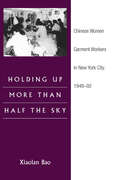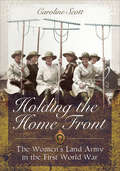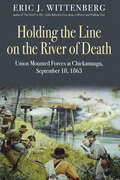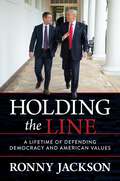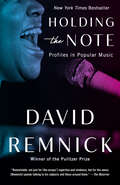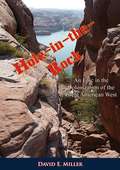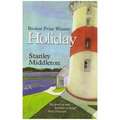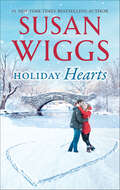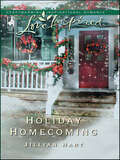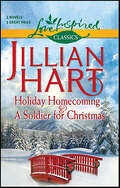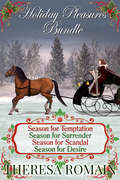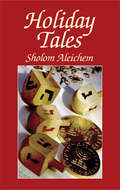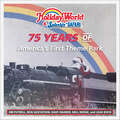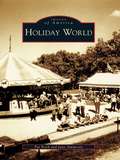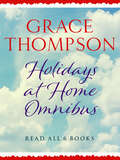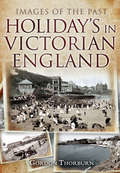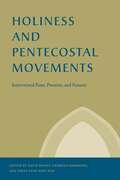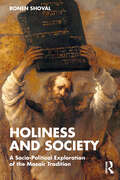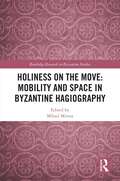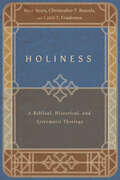- Table View
- List View
Holding Up More Than Half the Sky: Chinese Women Garment Workers in New York City, 1948-92
by Xiaolan BaoIn 1982, twenty thousand Chinese American garment workers--mostly women--went on strike in New York's Chinatown and forced Chinese garment industry employers in the city to sign a union contract. In this pioneering study, Xiaolan Bao penetrates to the heart of Chinese American society to explain how this militancy and organized protest, seemingly so at odds with traditional Chinese female behavior, came about. Blending poignant and dramatic personal stories culled from over a hundred interviews with a detailed history of the garment industry, Chinese immigrant labor, and the Chinese community in New York, Bao shows how the participation of married women in wage-earning labor outside the home profoundly transformed their image and relationships.
Holding Up More Than Half the Sky: Chinese Women Garment Workers in New York City, 1948-92 (Asian American Experience)
by Xiaolan BaoIn 1982, 20,000 Chinese-American garment workers—most of them women—went on strike in New York City. Every Chinese garment industry employer in the city soon signed a union contract. The successful action reflected the ways women's changing positions within their families and within the workplace galvanized them to stand up for themselves. Xiaolan Bao's now-classic study penetrates to the heart of Chinese American society to explain how this militancy and organized protest, seemingly so at odds with traditional Chinese female behavior, came about. Drawing on more than one hundred interviews, Bao blends the poignant personal stories of Chinese immigrant workers with the interwoven history of the garment industry and the city's Chinese community. Bao shows how the high rate of married women employed outside the home profoundly transformed family culture and with it the image and empowerment of Chinese American women. At the same time, she offers a complex and subtle discussion of the interplay of ethnic and class factors within New York's garment industry. Passionately told and prodigiously documented, Holding Up More Than Half the Sky examines the journey of a community's women through an era of change in the home, on the shop floor, and walking the picket line.
Holding the Home Front: The Women's Land Army in the First World War
by Caroline ScottAn &“insightful and extensive&” history of the women who took over agricultural duties in England during World War I (Sussex Living Magazine). One could be forgiven for supposing that the story of the Women&’s Land Army starts in 1939 during World War II. But it&’s a much older and more complicated history . . . British agricultural policy during the First World War was held up as a success story; domestic food production was higher at the end of the war than at the start, the average calorific value of the British diet barely changed, and bread never had to be rationed. As the press reported starvation and food riots overseas, the 1918 harvest was held up as &“one of the great achievements of the War.&” In 1917, at the darkest hour, when Britain&’s food security looked most precarious, it was said that, &“if it were not for the women agriculture would be absolutely at a standstill on many farms.&” Using previously unpublished accounts and photographs, this book is an attempt to understand how the return of women to the fields and farmyards impacted agriculture—and, in turn, an examination of how that experience affected them. &“Caroline&’s wonderful book sets the record straight with beautiful illustrations and witting testimony from people who were there and saw how hard these wonderful women worked to keep Britain going during their darkest hours. Superb.&” —Books Monthly &“This is a well-researched history of the British Women&’s Land Army in WW1 and how it paved the way for the success of the WLA in the Second World War.&” —World War One Illustrated
Holding the Line on the River of Death: Union Mounted Forces at Chickamauga, September 18, 1863
by Eric J. WittenbergThe award-winning Civil War historian examines the actions of Union Cavalry on the first day of the Battle of Chickamauga in this history and tour guide.This volume provides an in-depth study of the two important delaying actions conducted by mounted Union soldiers at Reed’s and Alexander’s bridges on the first day of Chickamauga. Much like Eric J, Wittenberg’s “The Devil’s to Pay”: John Buford at Gettysburg—which won the Gettysburg Civil War Roundtable’s 2015 Book Award—this volume combines engaging military history with a detailed walking and driving tour complete with the GPS coordinates.On September, 18, 1863, a cavalry brigade under Col. Robert H. G. Minty and Col. John T. Wilder’s legendary “Lightning Brigade” of mounted infantry made stout stands at a pair of chokepoints crossing Chickamauga Creek. Minty’s small cavalry brigade held off nearly ten times its number by designing and implementing a textbook example of a delaying action. Their efforts thwarted Confederate Gen. Braxton Bragg’s entire battle plan by delaying his army’s advance for an entire day. The appendices of this book include two orders of battle, a discussion of the tactics employed by the Union mounted force, and an epilogue on how the War Department and National Park Service have remembered these events. Complete with more than 60 photos and 15 maps by master cartographer Mark Anderson Moore, Holding the Line on the River of Death is a valuable addition to the burgeoning Chickamauga historiography.
Holding the Line: A Lifetime of Defending Democracy and American Values
by Ronny JacksonA behind-the-scenes political memoir written by a prominent White House physician.I would talk to the president before the chief of staff even saw the president in the morning. I walked into work, and I was already in the Oval Office talking to President Trump. It was rarely medical, to be honest with you; it was whatever was going on in the news. I&’d be the first person he&’d see in the morning. The president was completing tasks two to three hours before anybody else showed up in the West Wing to work. He&’d get up at five o&’clock in the morning and would be watching TV, tweeting, making phone calls, and doing all types of other tasks. President Trump would poke his head into my office or I&’d walk out, and we would say, &“Good morning. Did you see this or that?&” He was always asking me about things on TV and what was going on, from Iran to Stormy Daniels. He&’d say, &“Walk with me.&” So I&’d walk him to the Oval Office, and we&’d talk about everything. I&’d walk out through the outer Oval Office and the chief of staff, national security advisor, and even the CIA briefer would be standing there, waiting to get in and talk to him. I&’d walk out, they&’d walk in, and his day would start. I was the first person he saw every morning and the last person he saw every evening when he went to bed.
Holding the Note: Profiles in Popular Music
by David RemnickNEW YORK TIMES BEST SELLER • The Pulitzer Prize–winning journalist and editor of The New Yorker gathers his writing on some of the essential musicians of our time—intimate portraits of Leonard Cohen, Buddy Guy, Mavis Staples, Paul McCartney, Bruce Springsteen, Patti Smith, and more.The greatest popular songs, whether it&’s Aretha Franklin singing &“Respect&” or Bob Dylan performing &“Blind Willie McTell,&” have a way of embedding themselves in our memories. You remember a time and a place and a feeling when you hear that song again. In Holding the Note, David Remnick writes about the lives and work of some of the greatest musicians, songwriters, and performers of the past fifty years.He portrays a series of musical lives and their unique encounters with the passing of that essential element of music: time. From Cohen&’s performing debut, when his stage fright was so debilitating he couldn&’t get through &“Suzanne,&” to Franklin&’s iconic mink-drop at the Kennedy Center, Holding the Note delivers a view of some of the greatest creative minds of our time written with a lifetime&’s passionate attachment to music that has shaped us all.
Hole-in-the-Rock: An Epic in the Colonization of the Great American West
by David E. MillerFirst published in 1962, David E. Miller’s award-winning work on the Hole-in-the-Rock episode was arguably his greatest achievement as a historian. One of the great set-pieces of Mormon history, the San Juan Mission had become clouded by myth and hagiography when Miller first became attracted to its study in the 1950s, and few reliable sources were at that time available.Not content with exhausting archival material, Miller contacted all locatable descendants of the members of the original party, and thereby brought to light a great number of previously unexploited sources. The Hole-in-the-Rock study achieved additional depth from his intimate knowledge of the actual trail acquired on repeated traverses by Jeep and on foot.A member of the LDS Church, Miller wrote of the Mormons with sympathy and understanding, but with a commitment as well to the critical standards of the historical profession.A must-read for anyone interested in American History.
Holiday
by Stanley MiddletonEdwin Fisher has fled to a seaside resort of his childhood past to try to come to terms with the death of his baby son and the collapse of his marriage to Meg. On this strange and lonely holiday, as he seeks to understand what went wrong, Edwin must find someway to think about what he has been and decide upon where he can go next.<P><P> Man Booker Prize winner
Holiday Hearts: A Fairytale Christmas
by Susan WiggsEmbrace the holiday feeling with these two classic Christmas romances from #1 New York Times bestselling author Susan Wiggs.A FAIRYTALE CHRISTMASAce reporter Jack Riley loves his job, or at least he did until Madeleine Langston took over as publisher for the Courier. The perfect blonde ice queen is a daunting presence in the newsroom and an irresistible distraction, despite Jack’s determination to avoid her as often as possible. But when a chance encounter with a stranger transforms Jack from a scruffy journalist into a debonair Texan in a tux, he suddenly finds himself at the center of Madeleine’s attention. THE ST. JAMES AFFAIRElaine St. James has it all—a thriving career as an elite Manhattan publicist, A-list best friends and a gorgeous, high-profile boyfriend her parents adore. But when Byron breaks up with her on Christmas Eve, Elaine is faced with the prospect of spending the holidays alone…until Tony Fiore, the man she loved long ago, reappears like a ghost from Christmas past.Titles originally published in 1996 and 2003.
Holiday Homecoming
by Jillian HartKNIGHT IN A SHINING SUVShe was supposed to be home in Montana for Thanksgiving, but Kristin McKaslin was stranded at the Boise airport—in a snowstorm. There was no hope. Then, out of nowhere, a car pulled up. It was Ryan Sanders, the charming football player she'd barely known in high school. He was going home, too.Kristin's girl-next-door beauty had always stayed with Ryan, and she'd turned into an incredible woman. But he thought he loved another. So what was that hard knot doing in his gut when their all-night drive was over? Why didn't he want to see her go?Suddenly Ryan suspected the Lord might have more in mind than just a drive…
Holiday Homecoming & A Soldier for Christmas
by Jillian HartHoliday HomecomingWhen Kristin McKaslin finds herself snowbound for Thanksgiving, Ryan Sanders comes to her rescue. And as their paths cross again and again for each festive occasion, she starts to wonder. She came home for the holidays-would she be willing to stay for love?A Soldier for ChristmasIt's pure chance that has Mitch Dalton walking into Kelly Logan's shop. But when the soldier asks if he can write her, a correspondence courtship starts to thrive. After holiday leave brings Mitch home, he knows he can't leave again without Kelly's promise to be his Christmas bride.
Holiday House Parties: Two Tales
by Elizabeth MansfieldUnlikely lovers find passion under the Christmas mistletoe in this duet of Regency tales from an award-winning romance author. In &“The Girl with Airs,&” Lord Dunvegan—Laird Geordie to his friends—attempts to persuade bluestocking Caroline Woolcott to give his besotted, tongue-tied friend Sir Archibald Halford a chance to win her hand in marriage. A Scotsman banished to England to cultivate a more genteel manner, Geordie has yet to meet a female who tempts him to settle down. It certainly isn&’t the headstrong lass who wants nothing to do with Archie—or Geordie. But then Geordie&’s father decides the standoffish Caroline would make an ideal bride for his wayward son, and a sizzling kiss in the doorway of a grand Lancashire estate turns two warring hearts to love . . . In &“A Sneeze on Tuesday,&” Elinor Selby succumbs to the worst cold she&’s ever known five days before Christmas, and her entire future takes a catastrophic turn. After an absence of five years, Elinor&’s betrothed, Julian Henshaw, Lord Lovebourne, is due home any day. Were it not for her quick-thinking, curmudgeonly neighbor, Miles Endicott, on whom she&’s relied since childhood, she might not be able to cope with the momentous reunion. But then an unexpected series of events forces Elinor and Miles to take part in a scandalous deception that will ignite a firestorm of longing and love. Elizabeth Mansfield&’s pair of irresistible holiday romances features men and women who discover love they didn&’t know they were missing.
Holiday Pleasures (bundled set): Season for Temptation, Season for Surrender, Season for Scandal, Season for Desire
by Theresa Romain“Theresa Romain’s stories [are] full of lovely prose and endearing characters who readers can take to their hearts.”—RT Book ReviewsIn true Regency style, four spirited women find their way to their heart’s deepest desires amidst the glitter and whirl of the Christmas season . . . First there is Julia Herington, impetuous—and irresistible. Brilliant but shy, Louisa Oliver seems destined for spinsterhood until she finds herself the subject of a scandalous bet—and turns it to romantic advantage. And then there is Jane Tindall, a talent for deception her greatest treasure. Her daring taste for gambling draws her into a marriage of convenience that just might lead to love. Lady Audrina Bradleigh is expected to lead fashion and behave with propriety. But as she discovers on the wintry roads of Yorkshire, she is heedless of society’s proper rules when it comes to her heart’s desires. And only one season can twist all their strands of fate into a perfect gift to last a lifetime . . . Praise for Theresa Romain and her Holiday Pleasures “Theresa Romain writes witty, gorgeous, and deeply emotional historical romance.” —Vanessa Kelly, one of Booklist’s “new stars of historical romance” “Theresa Romain has a talent, a rare ability to blend beautiful writing, great characters, delicious banter and a lovely romance, all in one perfect package.” —TBQ’s Book Palace “If you’re looking for a sparkling, witty Regency romance that will have you laughing with joy and sighing with satisfaction, look no further than Theresa Romain’s Season for Temptation.” —The Romance Dish “A holiday charmer that is rife with lively wit, delightful prose, and an abundance of unforgettable characters.” —Library Journal on Season for Surrender “This third book in Theresa Romain's aptly named Holiday Pleasures series is both playful and profound, and has a subtle, stirring power that will affect you long after you've read the final page.” —USA Today’s Happy Ever After blog on Season for Scandal
Holiday Pleasures Bundle
by Theresa RomainIn true Regency style, four spirited women find their way to their heart's deepest desires amidst the glitter and whirl of the Christmas season . . . First there is Julia Herington, impetuous--and irresistible. Brilliant but shy, Louisa Oliver seems destined for spinsterhood until she finds herself the subject of a scandalous bet--and turns it to romantic advantage. And then there is Jane Tindall, a talent for deception her greatest treasure. Her daring taste for gambling draws her into a marriage of convenience that just might lead to love. Lady Audrina Bradleigh is expected to lead fashion and behave with propriety. But as she discovers on the wintry roads of Yorkshire, she is heedless of society's proper rules when it comes to her heart's desires. And only one season can twist all their strands of fate into a perfect gift to last a lifetime . . .
Holiday Tales
by Aliza Shevrin Sholom AleichemSeven childrens' tales, from one of the world's greatest writers of Yiddish stories. Centering around the Jewish holidays, stories include "Benny's Luck," about the amazing good fortune of a young boy and his dreydl, and "Really a Sukkah!" a glimpse of a busy holiday celebration that ends less happily than it began.
Holiday World & Splashin' Safari: 75 Years of America's First Theme Park
by Jim Futrell Dave Hahner Ron Gustafson Nell HedgeAmerica's first theme park, Holiday World & Splashin' Safari, is one of the largest family-owned and -operated independent parks in the United States, and its success is no accident. From moving Interstate 64 closer to the small town to introducing free unlimited soft drinks, four generations of the Koch family have amplified the legacy of this iconic Indiana attraction.Holiday World & Splashin' Safari celebrates the history of the Koch family and Santa Jim Yellig; the origins of Santa Claus, Indiana; and the early years of Santa Claus Land. The story continues with the expansion from Santa Claus Land to Holiday World, the addition of the park's famous trio of top-ranked wooden roller coasters, and the development of Splashin' Safari Water Park, ranked one of the top water parks in the country. For three-quarters of a century, the Koch family has launched the park into worldwide renown and national recognition. Featuring over 100 color illustrations, Holiday World & Splashin' Safari relives this joyous past while looking forward to the thrills fans can expect in the next 75 years.
Holiday World (Images of America)
by Pat Koch Jane AmmesonLouis J. Koch had a dream--one of family, fun, and Christmastime year-round. And so he created Santa Claus Land, the nation's first theme park, in Santa Claus, located in the gentle rolling hills of southern Indiana. Now, six decades later, Koch's legacy lives on at Holiday World and Splashin' Safari. Still owned and operated by the Koch family, Holiday World and Splashin' Safari are consistently voted the friendliest and cleanest parks in the country, and their wooden roller coasters are rated in the top ten list among coaster enthusiasts. The Koch family members treat visitors to the park as family and welcome everyone into what has become a true extension of their home.
Holidays at Home Omnibus
by Grace ThompsonThe beloved saga of a Welsh coastal community coping on the home front through World War II—six novels in one volume! These six heartwarming novels follow the inhabitants of St David&’s Wells, a small Welsh seaside town, charting the highs and lows they experience during the Second World War. From engagements to tragic accidents, the arrival of evacuees to the return of the local soldiers, ice cream indulgences to utter deprivation, this bestselling series from much-loved author Grace Thompson includes: Wait Till SummerSwingboats on the SandWaiting for YesterdayDay TrippersUnwise PromisesStreet Parties
Holidays in Victorian England (Images of the Past)
by Gordon ThorburnIn the country, holidaymakers were a rarity. The railways could take you almost anywhere, but it was only the middle classes who went. So there were no crowds, and many of our pictures show tourist hotspots before they were hot, before there was any such thing as a car park. The text provides local knowledge and background to the photographs and is an enjoyable read in itself, but the real pleasure is in seeing Brighton, Margate, Scarborough, Broadstairs, Clovelly, Ilfracombe, Minehead, before it all happened. See Exmoor, the White Peak, Somerset, when the loudest noise was the click of the camera shutter.
Holidays of the Revolution: Communist Identity in Israel, 1919-1965
by Amir Locker-BiletzkiHolidays of the Revolution explores a little-known chapter in the history of Mandatory Palestine and the State of Israel: the Israeli Communist Party and its youth movement, which posed a radical challenge to Zionism. Amir Locker-Biletzki examines the development of this movement from 1919 to 1965, concentrating on how Communists built a distinctive identity through myth and ritual. He addresses three key themes: identity construction through Jewish holidays (Hanukkah and Passover), through civic holidays (Holocaust Remembrance Day and Israeli Independence Day), and through Soviet and working-class myths and ceremonies (May Day and the October Revolution). He also shows how Jewish Communists viewed, interacted, and celebrated with their Palestinian comrades. Using extensive archival and newspaper sources, Locker-Biletzki argues that Jewish-Israeli Communists created a unique, dissident subculture. Simultaneously negating and absorbing the culture of Socialist-Zionism and Israeli Republicanism—as well as Soviet and left-wing–European traditions—Jewish Communists forged an Israeli identity beyond the bounds of Zionism.
Holiness and Pentecostal Movements: Intertwined Pasts, Presents, and Futures (Studies in the Holiness and Pentecostal Movements #1)
by David Bundy, Geordan Hammond, and David Sang-Ehil HanSince the 1830s, Holiness and Pentecostal movements have had a significant influence on many Christian churches, and they have been a central force in producing what is known today as World Christianity. This book demonstrates the advantages of analyzing them in relation to one another.The Salvation Army, the Church of the Nazarene, the Wesleyan Church, and the Free Methodist Church identify strongly with the Holiness Movement. The Assemblies of God and the Pentecostal Assemblies of the World identify just as strongly with the Pentecostal Movement. Complicating matters, denominations such as the Church of God (Cleveland), the International Holiness Pentecostal Church, and the Church of God in Christ have harmonized Holiness and Pentecostalism. This book, the first in the new series Studies in the Holiness and Pentecostal Movements, examines these complex relationships in a multidisciplinary fashion. Building on previous scholarship, the contributors provide new ways of understanding the relationships, influences, and circulation of ideas among these movements in the United States, the United Kingdom, India, and Southeast and East Asia.In addition to the editors, the contributors are Kimberly Ervin Alexander, Insik Choi, Robert A. Danielson, Chris E. W. Green, Henry H. Knight III, Frank D. Macchia, Luther Oconer, Cheryl J. Sanders, and Daniel Woods.
Holiness and Pentecostal Movements: Intertwined Pasts, Presents, and Futures (Studies in the Holiness and Pentecostal Movements)
by David Bundy, Geordan Hammond, and David Sang-Ehil HanSince the 1830s, Holiness and Pentecostal movements have had a significant influence on many Christian churches, and they have been a central force in producing what is known today as World Christianity. This book demonstrates the advantages of analyzing them in relation to one another.The Salvation Army, the Church of the Nazarene, the Wesleyan Church, and the Free Methodist Church identify strongly with the Holiness Movement. The Assemblies of God and the Pentecostal Assemblies of the World identify just as strongly with the Pentecostal Movement. Complicating matters, denominations such as the Church of God (Cleveland), the International Holiness Pentecostal Church, and the Church of God in Christ have harmonized Holiness and Pentecostalism. This book, the first in the new series Studies in the Holiness and Pentecostal Movements, examines these complex relationships in a multidisciplinary fashion. Building on previous scholarship, the contributors provide new ways of understanding the relationships, influences, and circulation of ideas among these movements in the United States, the United Kingdom, India, and Southeast and East Asia.In addition to the editors, the contributors are Kimberly Ervin Alexander, Insik Choi, Robert A. Danielson, Chris E. W. Green, Henry H. Knight III, Frank D. Macchia, Luther Oconer, Cheryl J. Sanders, and Daniel Woods.
Holiness and Society: A Socio-Political Exploration of the Mosaic Tradition
by Ronen ShovalExploring the subtle political philosophy within the Biblical narrative, this book presents enduring insights that complement Ancient Greek philosophy for contemporary political distinctions – uncovering overlooked socio-political ideologies to provide a unique perspective alongside the classical philosophical tradition.By adopting a sociological approach, Ronen Shovel interprets the Bible as a reflection of perspectives and ideologies, emphasizing the intricate dynamics between rulers and subjects, balancing justice, and power within societies. A key focus is the examination of holiness as a distinct political category, influencing institutions, ethics, justice, and even the use of force. This perspective challenges traditional religious scholarship, merging sociology with the concept of holiness.Holiness and Society enriches political philosophy, religious studies, and sociology, broadening their boundaries and offering fresh perspectives, serving as a bridge between antiquity and modernity, providing valuable insights into contemporary political thought.
Holiness on the Move: Mobility and Space in Byzantine Hagiography (Routledge Research in Byzantine Studies)
by Mihail MitreaHoliness on the Move: Mobility and Space in Byzantine Hagiography explores the literary, religious, and social functions of monastic mobility in Byzantine hagiography, touching on aspects of space, narrative, and identity. The ten chapters included in this volume highlight the multifaceted and rich nature of travel narratives, exploring topics such as authorship and audience, narrative structure and function, identity-making and practicalities of and discourse on travel. In terms of geographical span, the case studies cover Constantinople and its hinterland, Asia Minor, mainland Greece, Trebizond, the Balkans, and southern Italy and range chronologically from the end of the sixth to the fourteenth century. The contributions offer novel insights and perspectives on the importance of mobility in the literary construction of holiness in the Byzantine world and the wider medieval Mediterranean, the spatial dimension of sacred mobility, and the ways in which mobility is employed in the narrative construction of hagiographical texts. As such, the volume joins the burgeoning research on sacred mobilities and will interest students and scholars of Byzantine and medieval literature, religion, and history, as well as a wider readership with an interest in the study of space and mobility.
Holiness: A Biblical, Historical, and Systematic Theology
by Matt Ayars Christopher T. Bounds Caleb T. FriedemanBe holy because I am holy. Be perfect as your heavenly Father is perfect. The Christian life includes many demands, but perhaps none are as challenging or as misunderstood as the biblical command to "be holy" (Leviticus 11:44 and 1 Peter 1:16) or to "be perfect" (Matthew 5:48). How should we understand these charges? In this volume, three scholars from the Wesleyan tradition offer a collective treatment of the theme of holiness that includes: exegesis of key biblical passages a survey across church history theological reflections on the relationship between entire sanctification and other doctrines In addition, the coauthors constructively argue for a "neo-holiness" model that encourages the pursuit of Christian perfection but avoids the pitfalls of Pelagianism by incorporating historic understandings of grace and the work of the Holy Spirit with the best of the Wesleyan tradition. Here, the commands to "be holy" and to "be perfect" take on new meaning. What may have been a burden becomes a blessing.
